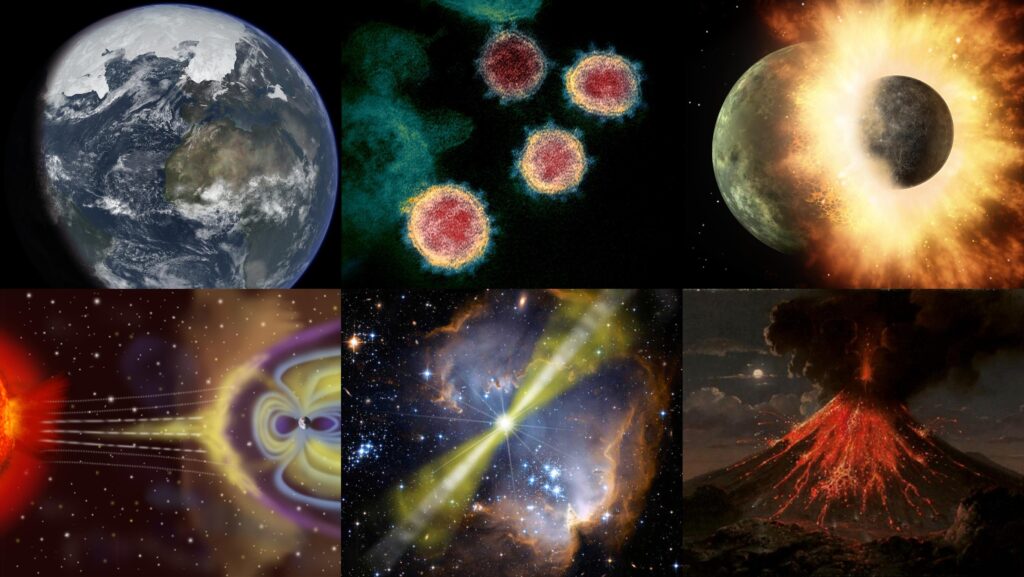
View the paper “Assessing Natural Global Catastrophic Risks”
Humanity today faces a wide range of threats. Some, such as nuclear war, are of human origin. Others, such as volcano eruptions, are not. The relative importance of these two categories of risk is a matter of ongoing debate. This paper argues that prior theoretical research has understated the risk from natural threats. It presents analysis of six natural global catastrophic risks, finding potential for several to pose a high ongoing risk to humanity.
Prior research has posed a paradox of sorts: if the risk to humanity from natural hazards is so large, then why do we exist? The human species has existed for about 200,000 years, and our ancestors for even longer. Natural hazards have existed throughout this time. If they posed a significant risk, then humanity probably would have been wiped out a long time ago—yet here we are. Prior research has taken this observation about deep human history to imply a low ongoing global catastrophic risk from natural hazards, especially in comparison to anthropogenic hazards.
This paper finds two flaws with the above reasoning. First, it applies only to the risk of human extinction. Evidence from deep human history is of less relevance to other forms of global catastrophe, such as the collapse of modern global civilization. Second, there is a moral case to be made for caring about the risk of “smaller” global catastrophes like civilization collapse to a degree similar to the risk of human extinction. The relative importance of collapse and extinction is uncertain, and so the paper presents a mathematical formulation to characterize this uncertainty for the analysis of global catastrophic risks.
With this theoretical perspective in mind, the paper then analyses six natural global catastrophic risks:
1) Natural climate change could in theory cause global catastrophe, such as via a new ice age. However, in practice, anthropogenic climate change (due mainly to greenhouse gas emissions) are drowning out the natural changes. For this reason, natural climate change is not a significant threat at this time and will not become one for at least several tens of thousands of years.
2) Natural pandemics could be a significantly larger risk than they were earlier in human history. For most of human history, it may have been difficult for pathogens to cause human extinction because the human population was geographically fragmented. In contrast, modern transportation facilitates global pathogen spread. Pandemics could also pose a risk of civilization collapse.
3) Near-Earth objects (asteroids, comets, and meteors) collide with Earth at approximately the same rate as occurred earlier in human history. However, some collision events may be able to cause civilization collapse even if they couldn’t cause human extinction. Additionally, some catastrophe scenarios involve modern technology, such as if the explosion from a collision event is mistaken for a nuclear attack, thereby triggering nuclear war.
4) Space weather (coronal mass ejections, solar flares, and solar particle events) posed essentially zero risk for most of human history but pose a significant risk to modern civilization. That is because they primarily damage technology such as power grids, oil and gas pipelines, satellites, and railroads. Space weather may pose a significant ongoing global catastrophic risk.
5) Stellar explosions (gamma ray bursts and supernovae) within nearby portions of the Milky Way galaxy would destroy all life on Earth. This risk has not meaningfully changed across human history. However, these are extremely rare events, such that they are not a significant global catastrophic risk for humanity at this time.
6) Volcanic eruptions have always posed some threat to humanity. Indeed, the eruption of Mount Toba (now Lake Toba in Indonesia) 75,000 may have been the most extreme catastrophe in human history. Eruptions also pose some new risks to civilization, such as due to the large population centers along the Ring of Fire, though it is less clear if an eruption event of this sort would constitute a global catastrophe.
In consideration of these six risks, four conclusions emerge. First, the distinction between natural and anthropogenic global catastrophic risks is blurry, due to the many ways in which human civilization plays a role in the risks. Second, several natural global catastrophic risks have potential to be large, especially natural pandemics, near-Earth objects, and space weather, though further research is needed to assess just how large the risks are. Third, deep human history provides little insight into the ongoing risk of global catastrophe from natural hazards. Fourth and finally, an important point of uncertainty is the relative significance of human extinction vs. other global catastrophe scenarios such as civilization collapse.
This paper extends GCRI’s research on cross-risk evaluation and prioritization, especially the paper Long-term trajectories of human civilization.
Academic citation:
Baum, Seth D., 2023. Assessing natural global catastrophic risks. Natural Hazards, vol. 115, no. 3 (February), pages 2699-2719, DOI 10.1007/s11069-022-05660-w. ReadCube.
Image credits:
Ice age Earth: Ittiz
Electron microscope image of virus: NIAID
Asteroid collision: NASA
Space weather/magnetosphere: NASA
Gamma ray burst: NASA
Volcano eruption: Raden Saleh







